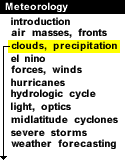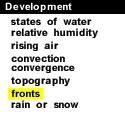
|
Lifting also occurs along frontal boundaries, which separate air masses of different density.

In the case of a cold front, a colder, denser air mass lifts the warm, moist air ahead of it. As the air rises, it cools and its moisture condenses to produce clouds and precipitation. Due to the steep slope of a cold front, vigorous rising motion is often produced, leading to the development of showers and occasionally severe thunderstorms.

In the case of a warm front, the warm, less dense air rises up and over the colder air ahead of the front. Again, the air cools as it rises and its moisture condenses to produce clouds and precipitation. Warm fronts have a gentler slope and generally move more slowly than cold fronts, so the rising motion along warm fronts is much more gradual. Precipitation that develops in advance of a surface warm front is typically steady and more widespread than precipitation associated with a cold front.

topography |
|

rain or snow |




